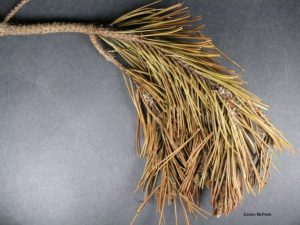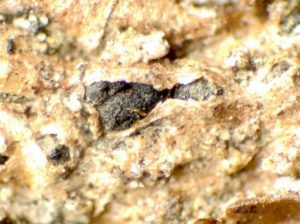Diplodia Tip Blight
Pest Management Fact Sheet #5102
Authors: Dr. Alicyn Smart, Dr. Bruce Watt, and Abigayl Novak
For information about UMaine Extension programs and resources, visit extension.umaine.edu.
Find more of our publications and books at extension.umaine.edu/publications/.
Other Name: Sphaeropsis sapinea and Diplodia pinea
Pathogen: Sphaeropsis sapinea
Introduction

This disease can be very destructive to two- and three-needle pines and commonly infects trees planted outside of their natural range. Damage to native trees is not commonly seen.
The spores of this fungus can germinate and infect the tree over a wide range of temperatures. After the germination, the fungus infects the needle by entering the stomata. The fungus then infects the twig, and the needles become brown and form a canker on the twig (Figure 1). Although the spores require free water, as little as 12 hours of wetness is sufficient for infection. During wet springs, spores will be produced in great numbers and are readily spread by the splashing of rain. Trees that are in poor health due to environmental or cultural stress are more susceptible to infection then healthy trees.
Diplodia tip blight overwinters in diseased needles, cankers, and especially in two-year-old cones, which account for the increased incidence of the disease in older trees. The pathogen survives well on dead plant tissues and produces spores within a year after infection. These spores ooze out of a fruiting structure called pycnidia during wet weather and are carried to susceptible healthy tissue by the splashing of rain (Figure 2). Developing shoots and needles are especially vulnerable to infection.
Host Plants
- All species of Pine (Pinus) — Austrian Pine (Pinus nigra) severely affected
- Douglas-fir (Pseudotsuga menziesii)
- White Spruce (Picea glauca), Norway Spruce (Picea abies), and Blue Spruce (Picea pungens)
Symptoms and Signs

This fungus mostly attacks mature trees that are under stress from drought, root restriction, or other planting site problems. The most readily observed symptom is the curling and death of new shoots that have become infected in early spring. Before this, needles can turn yellow and brown before they have fully expanded. Fruiting bodies (pycnidia) of the fungus can be seen as black dots at the base of the needles, especially toward the end of the season. Pycnidia are often found under the needle sheaths and can also be found on the cone scales and the shoots. The disease tends to be most severe on older trees and is less common in nurseries. Although symptoms can be found in all parts of the crown, the lower branches tend to be more severely infected because of how the fungal spores are washed down through the tree by the rain. This fungus can also infect stems through wounds, leading to resinous cankers.
Management
- Maintain the health of the tree by avoiding improper planting site selection and water during droughts when plants are young.
- Collect all fallen cones and dispose of them to limit the spread of the disease.
- Avoid planting too close to other plants that can limit airflow.
- Do not apply fertilizer with high amounts of nitrogen.
- Prune diseased branches to limit the spread of the disease. Avoid pruning during wet weather and sanitize pruning shears with 70% rubbing alcohol between cuts to minimize spreading the disease.
- Preventative fungicides can be used at bud break and again in two weeks.
Protective fungicides available for control of this disease must be applied during the spring just before bud break and periodically thereafter to protect new growth as it expands. Appropriate fungicides are listed below:
| Appropriate Fungicides for Diplodia Tip Blight |
||
|---|---|---|
| Fungicide | Application Notes | Examples of Trade Names |
| Azoxystrobin | Typical application interval 7 to 14 days. See label to verify. | Quadris, Amistar, Cabrio EG |
| Bordeaux mix | See label for timing. | |
| Propiconazole | Apply when you first see symptoms on a 14-21 day schedule | Banner Maxx |
| Thiophanate-methyl | Apply at early bloom. See label. | Topsin-M |
You should check your local town ordinance for any pesticide restrictions before application.
References
Sandra Lorraine Jensen. Diplodia Tip Blight: Sphaeropsis sapinea. n.d. <http://plantclinic.cornell.edu/factsheets/sphaeropsisdiplodia.pdf>.
Wallis, Chris, Dennis J. Lewandowski and Pierluigi (Enrico) Bonello. Diplodia Tip Blight of Two-Needled Pines. 15 April 2016. <https://ohioline.osu.edu/factsheet/plpath-tree-03>.
WHEN USING PESTICIDES, ALWAYS FOLLOW LABEL DIRECTIONS!
Alicyn Smart, DPM
Plant Pathologist and Director of the Plant Disease Diagnostic Laboratory
University of Maine Cooperative Extension
Information in this publication is provided purely for educational purposes. No responsibility is assumed for any problems associated with the use of products or services mentioned. No endorsement of products or companies is intended, nor is criticism of unnamed products or companies implied.
© 2010, 2019
Call 800.287.0274 (in Maine), or 207.581.3188, for information on publications and program offerings from University of Maine Cooperative Extension, or visit extension.umaine.edu.
The University of Maine is an EEO/AA employer, and does not discriminate on the grounds of race, color, religion, sex, sexual orientation, transgender status, gender expression, national origin, citizenship status, age, disability, genetic information or veteran’s status in employment, education, and all other programs and activities. The following person has been designated to handle inquiries regarding non-discrimination policies: Director of Equal Opportunity, 101 North Stevens Hall, University of Maine, Orono, ME 04469-5754, 207.581.1226, TTY 711 (Maine Relay System).

